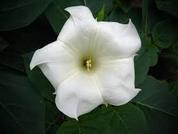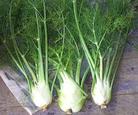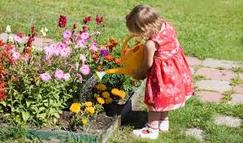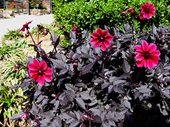|
Ozark Green Thumb BCMG Monthly e-Newsletter |
|
|
|
JULY CHECKLIST FOR GARDENERS
The following is a garden checklist:
Mark D. Keaton County Extension Agent- Telephone: 425-2335 For more information on any of the above points, contact the University of Arkansas Division of Agriculture Cooperative Extension Service at 425-2335.
0 Comments
 Moonflower is a fast-growing, old-fashioned annual vine that seems to have been forgotten by gardeners as they explore the new offerings of the garden industry. Who has the patience to actually grow a plant from seed and wait several months for it to bloom? We want it now, thank you. Moonflower (Ipomoea alba) is a close relative of morning glory and, like it, produces a long, slender, twining vine capable of growing a dozen or more feet high in the course of a year. The vine is capable of climbing a string, a chain link fence or sprawling over nearby shrubs.
It’s now established as an escaped plant throughout most of the world’s tropical areas, but it probably originated in Central America. In the deep South it forms a tuberous root and will survive as a perennial, but in most of Arkansas it’s annual. Plants grow quickly from seed, forming large heart-shaped leaves up to 6 inches across. The moonflower blooms best in late summer and early fall, provided it doesn’t get too dry. The delicate, ephemeral white blooms are solitary and 5 to 6 inches across with a long, slender tube. Each blossom is marked with a narrow, five-pointed star in a slightly different shade of white. Blooms open in late afternoon and are closed by the morning. Though I’ve not seen it, I suspect the large luna moth with its 6-inch long coiled proboscis provides pollination services. Moonflower vines coil clockwise, regardless of where or how they are grown. Charles Darwin published his Movement and Habits of Climbing Plants in 1875 where he detailed his experiments and observation. He observed that some species twined in one direction while some went the other way and was unable to reverse the direction by applying different stimuli. The often heard statement that twining is reversed in the Southern Hemisphere is not correct. They’re programmed to rotate in only one direction. Moonflower seeds were studied in the 1970s to see if they contained lysergic acid, a natural alkaloid called ergine which is remarkably similar in chemical structure to the hallucinogenic drug LSD. Unlike the common morning glory, moonflower was found to have no hallucinogenic properties. Growing moonflowers from seed is easy. Because they have a hard seed coat, nicking the seed coat with a knife tip or rubbing seeds with a piece of sandpaper will improve germination. This is probably not necessary with seeds obtained from the seed companies but may help with pass-along seeds. Seeds can be planted it in any reasonably good garden soil that receives at least six hours of bright light during the day, but don’t plant until the soil temperature has warmed above 65 degrees Fahrenheit. If you’re in a hurry, seeds can be planted indoors in a container and then transplanted to the garden when the soil warms. By: Gerald Klingaman, retired Extension Horticulturist - Ornamentals Extension News - September 16, 2005  The best garden plants are easy to grow and satisfy specific needs; plus, they look good. Fennel (Foeniculum vulgare) is one of the best garden plants because it is attractive, easy to grow and satisfies lots of very specific needs. You can eat it, it is a good weaver plant in the perennial border and it hosts the caterpillars of the eastern black swallowtail. Fennel is an upright-growing perennial herb of the carrot family growing to 6 feet tall, which produces a number of hollow stems from a deep, taprooted crown. Its leaves are finely dissected to 16 inches long and terminate in threadlike filaments. The most common form, the bronze fennel (variety Purpureum), has maroon/bronze leaves, which give the plant a smoky-like look. All parts of the plant have a licorice-like scent when crushed. Florence fennel of the Azoricum Group grows only 3 feet tall and produces a cluster of swollen leaf bases that form a bulb-like swelling at the base of the leaf. This fennel is grown as an annual crop, with the “bulbs” harvested while succulent and sweet. This is eaten as a cooked vegetable and is often found in U.S. markets under its Italian name, finocchio. Yellow flower clusters in flat-topped umbels to 3 inches across appear in midsummer near the ends of the stems. Individual flowers are tiny and give rise to a single “seed,” which has culinary uses. Fennel is a Mediterranean plant that is now found naturalized throughout the world, especially in areas such as California, which has a similar climate. Its leaves are used as a flavoring similar to dill weed when cooking fish, and as an ingredient in stuffing recipes. Its seeds are a favorite in Italian cooking. In garden design, fennel is an excellent addition to the vegetable garden or the mixed perennial border. Though it can reach considerable height, its deep taproot and finely dissected leaves make it a good neighbor, and other plants can grow next to it without being crowded out. Plants are hardy from zones 5 through 9, making it one of the most cold-hardy members of this genus. Fennel is a must-have plant if the aim is to attract butterflies into the garden for it. Along with carrot, dill, parsley and Queen Anne’s lace, fennel is a preferred food plant for the caterpillars of the eastern black swallowtail. The caterpillars are two inches long, with concentric rings of black and yellow. They are voracious feeders and can strip young plants of most of their foliage, but fennel is tough enough — it responds by sending out a fresh supply of leaves.
Fennel requires sunny, well-drained soils but seems to tolerate both alkaline and acidic sites. It has good drought tolerance late in the year, but needs moisture during establishment to ensure the formation of a strong root system. Once established, fennel can be long-lived in the garden. Plants are semi-evergreen and serve as sites for overwintering eggs of the swallowtail butterfly. By: Gerald Klingaman, retired Retired Extension Horticulturist - Ornamentals Extension News - September 16, 2011  Many people ponder how to water a garden. They may struggle over questions such as, “How much water should I give my garden?” or “How often should I water a garden?” It’s really not as complicated as it seems, but there are some things that should be considered. These include the type of soil you have, what your climate or weather is like, and the types of plants you are growing. Many people ponder how to water a garden. They may struggle over questions such as, “How much water should I give my garden?” or “How often should I water a garden?” It’s really not as complicated as it seems, but there are some things that should be considered. These include the type of soil you have, what your climate or weather is like, and the types of plants you are growing. First, consider your soil. Sandy soil is going to hold less water than heavier clay soil. Therefore, it’s going to dry out faster while the clay-like soil will hold moisture longer (and is more susceptible to over watering). This is why amending the soil with compost is so important. Healthier soil drains better but allows for some water retention too. Appying mulch is also a good idea, reducing watering needs. Weather conditions determine when to water garden plants as well. If it is hot and dry, for example, you’ll have to water more often. Of course, in rainy conditions, little watering is needed. Plants, too, dictate when and how often to water. Different plants have different watering needs. Larger plants need more water as do newly planted ones. Vegetables, bedding plants and many perennials have more shallow roots systems and also require more frequent watering, some daily–especially in temps over 85 F. (29 C.). Most container plants need watering on a daily basis in hot, dry conditions — sometimes twice or even three times a day. When to water gardens also includes the time of day. The most suitable time for watering is morning, which reduces evaporation, but late afternoon is okay as well provided you keep the foliage from getting wet, which can lead to fungal issues. Deep watering encourages deeper and stronger root growth. Therefore, watering gardens about 2 inches or so once a week is preferable. Watering more often, but less deep, only leads to weaker root growth and evaporation. Overhead sprinklers are often frowned upon, with exception to lawns, as these also lose more water to evaporation. Soaker hoses or drip irrigation is always better, going straight to the roots while keeping foliage dry. Of course, there’s also the old standby—hand watering—but since this is more time consuming, it’s best left for smaller garden areas and container plants. Knowing when and how to water a garden correctly can ensure a healthy growing season with lush plants. Article printed from Gardening Know How: https://www.gardeningknowhow.com
 The ebb and flow of plants in the garden world is nonstop with some plants gaining popularity while others disappear into the void, only to return as a new generation of gardeners discover them. Forty years ago as I drove the back roads of Arkansas I used to see some large dahlia plantings, but today I would be hard pressed to even find a single plant. However, that could change as a new wave of black leafed dahlias becomes better known. Dahlias are herbaceous perennials of the daisy family native to the mountains of Mexico and Central America. They were cultivated by the Aztecs during the time of the Spanish conquest (1519-1524) but were not introduced into Europe until 1789. There are about 27 species of dahlias known with most of the garden hybrids derived from crosses between Dahlia coccinea and D. pinnata. In nature dahlias are large, frost-tender herbaceous plants growing 6 to 20 feet tall with fleshy tuberous roots. When first introduced to Europe they were touted as a new food crop to compete with potatoes but it was soon discovered the tubers were “edible but not agreeable” and even rejected by livestock. By the 1830s, dahlias were one of the most fashionable plants in European gardens and several hundred cultivars were available during this period. By the 1880s, they had gained their own plant society and new momentum when the large cactus flowered types began to appear. Over the past two centuries, more than 50,000 cultivars have been named. The large traditional dahlias are a hands-on kind of garden flower. To keep them looking well they must be tended, fussed with and cultivated. The large types require staking and pruning to keep them looking their best and a considerable amount of room in the garden. At the end of the growing season the tubers must be dug and stored over winter in a frost free area. This commitment of time and energy in today’s busy world has cut into the popularity of the plants. Attempts at remaking the image of the dahlia as a foot-tall bedding plant that is grown from seed have been ongoing over the past five decades, but has never really caught on with the gardening public. Newer attempts to introduce selections with an intermediate form for use in containers and mixed into the garden border may be more promising. Black-leafed selections add color and contrast to the garden even when plants are not in flower. Verwer Dahlias, a Dutch company established in 1967 near Haarlem, Netherlands, has taken the lead in developing many new dahlia clones including the black leafed Dark Angel series that average around two feet tall with 3-inch single or anemone type flowers in shades of pink and red. Dahlias need full sun, a rich garden soil and attention to watering needs during the summer months. They do best in areas with bright, warm days and cool nights where they will flower during the summer and fall. Most of the modern cultivars are considered ever-blooming but in hot climates the blooms will be more concentrated during the latter part of the summer and fall when night temperatures have begun to drop. Deadheading and pinching is required to keep the plants full and floriferous. Tubers should be lifted after the first light frost and stored in dry peat moss in a well ventilated, frost-free area. By: Gerald Klingaman, retired
Retired Extension Horticulturist - Ornamentals Extension News - October 19, 2012  Prep: 20 minutes Marinate: 1 to 24 hours Grill: 17 minutes Stand: 10 minutes Makes 8 servings Ingredients
Directions:
1. Trim fat from meat. Score both sides of meat in a diamond pattern by making shallow cuts at 1- inch intervals; set aside. In a small bowl stir together rosemary, marjoram, oregano, garlic, paprika, kosher salt crushed red pepper and black pepper. Stir in the oil until combined. 2. Spoon herb mixture evenly over both sides of steak; rub in with your fingers. Place steak in a shallow dish. Cover and marinate in the refrigerator 1 to 24 hours. 3. For a charcoal grill, place meat on the rack on an uncovered and grill directly over medium coals. Grill for 17 to 21 minutes or until medium wellness (160F), turning once halfway through grilling. For a gas grill, preheat grill. Reduce heat to medium. Place meat on grill rack over heat. Cover and grill as above. 4. Transfer grilled meat to a cutting board. Cover and let stand for 10 minutes. To serve, slice very thinly across the grain.  An easy and delicious salad make with the fresh produce from your garden. Makes four servings. Ingredients
Directions
1. Place kale in large mixing bowl. Top with remaining ingredients and mix well. 2. Portion into salad bowls for serving. Top with oil and vinegar or your favorite Balsamic dressing and serve. |
Archives
April 2022
|
|
